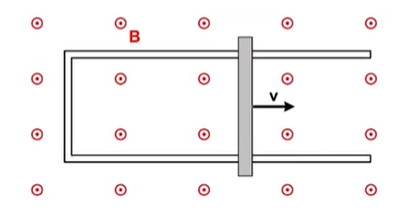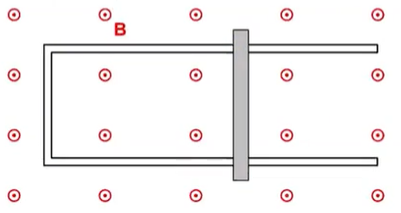Lenz’s Law gives us the direction of an induced current with the magnitude given by Faraday’s Law.
Induced current creates its own magnetic field, given by Ampere’s Law and Biot-Savart Law. The magnetic field created opposes the change in magnetic flux, and is the reason for the negative sign in Faraday’s Law.
In that way, Lenz’s law is a statement of Conservation of Energy.
Steps to Apply Lenz’s Law:
- Determine the direction of The Magnetic Field.
- Determine whether Magnetic Flux is increasing or decreasing.
- If flux is increasing, induced current creates a magnetic field in the opposite direction of the current magnetic field.
- If flux is decreasing, induced current creates a magnetic field in the same direction of the current magnetic field.
For example:
 Here is a loop created by a metal bar and rod. The metal bar is moving to the right, and there is a magnetic field out of the page. What is the direction of the induced current?
Here is a loop created by a metal bar and rod. The metal bar is moving to the right, and there is a magnetic field out of the page. What is the direction of the induced current?
Answer
Since flux is increasing from the increasing area of the loop, there is a magnetic field created in the opposite direction of the current magnetic field. As a result, the net magnetic field out of the page decreases.
We then use the Right-hand Rule for Rotation to determine the direction of the current. The net magnetic field is increasing downwards, so our thumb points downwards, and our fingers curl clockwise. There is a clockwise current.
Another example:
 In this case, the bar isn’t moving, but the strength of the magnetic field is decreasing. What is the direction of the induced current?
In this case, the bar isn’t moving, but the strength of the magnetic field is decreasing. What is the direction of the induced current?
Answer
If the strength of the magnetic field is decreasing, then flux is decreasing, meaning that there is a magnetic field created in the same direction as the current one. In other words, the magnetic field out of the page is increasing.
Once again using the Right-hand Rule for Rotation, we find that the induced current points counter-clockwise.